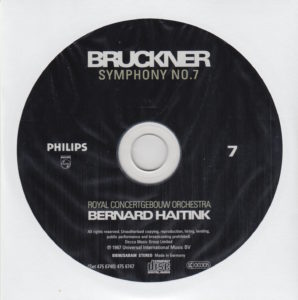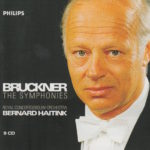 This morning’s conductor of Anton Bruckner’s Symphony No. 7 in E Major (WAB 107) is Dutch conductor Bernard Haitink (1929-).
This morning’s conductor of Anton Bruckner’s Symphony No. 7 in E Major (WAB 107) is Dutch conductor Bernard Haitink (1929-).
The orchestra is Royal Concertgebouw Orchestra.
I first encountered Maestro Haitink on Day 5 , Symphony No. 1, of my 144-day project.
Then again on Day 21, Symphony No. 2.
And again on Day 37, Symphony No. 3.
And again on Day 53, Symphony No. 4.
And again on Day 69, Symphony No. 5.
And again on Day 83, Symphony No. 6 – from the Bruckner Collection box set.
And again, most recently, on Day 85, Symphony No. 6 – from the Haitink box set.
That’s a lot of Haitink.
Thankfully, I have been deeply impressed with Maestro Haitink. Whatever “it” is that makes a recording magical, his recordings usually have it.
But I’ll reserve the subjective stuff for later.
First, the objective aspects of this recording.
 Bruckner’s Symphony No. 7 in E Major (WAB 107), composed 1881-1883
Bruckner’s Symphony No. 7 in E Major (WAB 107), composed 1881-1883
Bernard Haitink conducts
Haitink used the Haas edition
Royal Concertgebouw Orchestra plays
The symphony clocks in at 60:15
This was recorded in Amsterdam in November of 1966
Haitink was 37 when he conducted it
Bruckner was 59 when he finished composing it
This recording was released on the Philips label
Bruckner wrote his symphonies in four parts. The time breakdown of this one (Symphony No. 7 in E Major, Haas edition), from this particular conductor (Haitink) and this particular orchestra (Royal Concertgebouw Orchestra) is as follows:
I. Allegro moderato…………………………………………………………………………18:10
II. Adagio. Sehr feierlich und sehr langsam…………………………………..21:00
III. Scherzo. Sehr schnell…………………………………………………………………..9:19
IV. Finale. Bewegt, doch nicht schnell……………………………………………11:46
Total running time: 60:15
The fine print at the bottom of the last page of the liner notes reads:
The recording of Symphonies Nos. 1-9 was based on the edition prepared by Robert Haas…
According to its entry on Wikipedia, the Haas edition,
Haas edition (published 1944)
Robert Haas attempted to remove the influence of Nikisch, Schalk and Löwe in order to retrieve Bruckner’s original conception of the symphony. Haas used some material from the 1883 autograph but because this autograph also includes later changes much of his work was the product of conjecture. The most prominent feature of Haas’s edition is the absence of cymbals, triangle and timpani in the slow movement: Haas asserted that Bruckner decided to omit the percussion, a claim scholar Benjamin Korstvedt deems “implausible”.
Now, the subjective aspects of today’s performance…
My Rating:
Recording quality: 4 (some noticeable tape hiss at the start of Movement I, but far less than in previous)
Overall musicianship: 5
CD liner notes: 4 (essay translated into English, German, and French)
How does this make me feel: 3
I usually rave about Haitink’s interpretations.
This time, however, I can’t.
For one thing, the brass sounded really brassy. (And I hope you understand what I mean by that. I know brass will never sound woodwindy. I refer to how its recorded. If the brass instruments sound too shrill in my ears then it detracts from my enjoyment of the performance.)
Plus, to me, this performance seemed to lack energy. I wouldn’t say the orchestra was lethargic. But I can’t say it was brimming over with enthusiasm, either.
How this manifests itself is in the first two movements, in particular. They comprise over half of Bruckner’s Seventh. If they are not crackling with energy – especially the longer Adagio – then listening is tedious.
Of course, I liked the Wagnerian Scherzo with its over-the-top, Viking-like boldness. But even that wasn’t moving me like it did in previous performances. It was stirring, yes. In parts. The Wagnerian parts. But I didn’t get the Wow Factor from it.
This was an awesomely average performance.
